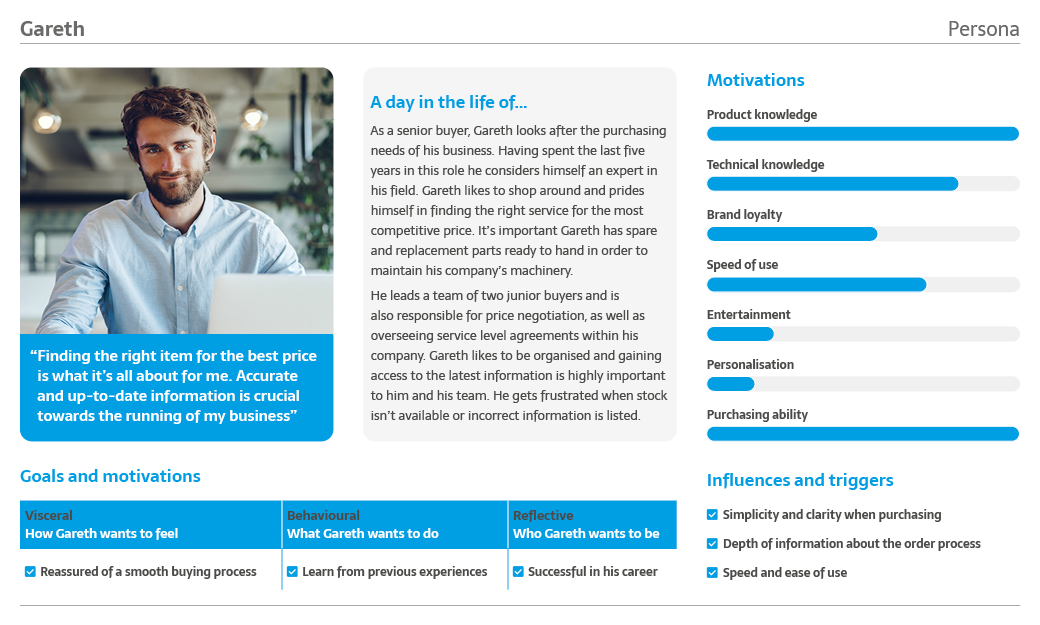The most effective B2B marketing is rooted in a strong understanding of – and balance between – both rational purchase drivers and the human, emotional motivations of the target audience.
Of course, to do this well you need to have a thorough understanding of who you’re looking to communicate with; what are the most important factors in getting them to engage with your brand, make a purchase and come back for more?
One view on this challenge, as David Ogilvy put it, is that “The trouble with market research is that people don’t think what they feel, they don’t say what they think and they don’t do what they say.” Although any market researcher worth their salt would argue that’s extremely reductive and that we’ve simply included the quote because it’s a great soundbite, there is some truth in so far as there is a fine balance between how and when quant and qual data is useful.
…as David Ogilvy put it, is that “The trouble with market research is that people don’t think what they feel, they don’t say what they think and they don’t do what they say.”
That’s the case in particular when looking at structuring personas for B2B customers. There will be a whole gamut of quantifiable information on who, how, and what to target to best generate leads. But unless you’re getting under the skin of the people involved in agreeing that purchase, understanding how they tick on an instinctive, irrational level, you won’t be promoting your brand as effectively as you could be.
This is the foundation of the work we do at Lesniak Swann – you can read more about the thinking behind it here: lesniakswann.com/news-and-thoughts/the-formula-for-your-next-b2b-marketing-campaign-2
In short, keep the stats and numbers – no one can argue they have a crucial role to play. But make sure assets such as personas, where the focus is on building an instructive picture of the individual you want to communicate with, prioritise giving clarity on the human aspects your marketing activity needs to consider.
Face it.
The example we’ve included shows how we typically structure personas to ensure that human element comes across effectively.

- A name and face is given to the persona. Although this might seem twee, it can play an important role in generating empathy for the persona and enhancing communications.
- A quote from the perspective of the persona individual is used as the headline. This should encapsulate the most important aspects of their job that a brand should align with and offer solutions to achieve.
- This is expanded upon in a short narrative section giving more information on the individual’s role. This story-based section isn’t just about the emotional state of the target audience – using this narrative format is a highly effective way to ensure those reading the information remember what it contains. After all, subsequent communications through any marketing channel will need to be interpreting this very same story.
- Goals and motivations are focussed on human aspirations – how they want to feel, what they want to do, what they want to be. This is an effective way of ensuring that the information mapped out at the segmentation stage such as purchase drivers is communicated in a way that ensures the individual is considered as the central factor.
- Purchase criteria is laid out in a clear, graphical fashion – allowing easy understanding of priorities and comparisons with other personas.
- In many cases, there will be a greater range of information that you can usefully display on one page. In these situations, it’s important to maintain a short, “at a glance” version which can be used alongside longer versions for when further information on behavior, preferred marketing channels etc. is needed.
Volume or value.
On first consideration, making sure you have a comprehensive range of detailed personas for all target audiences and sub-audiences may seem like the best way to bring clarity and focus.
But generally speaking, we’ve found that there is a law of diminishing returns with a higher number of personas. It becomes more difficult to achieve desired value from marketing – i.e. a satisfactory level of cut-through and saliency – with multiple different messages in play across audiences that often cross over to some degree. Plus, more personas means more potential for confusion within marketing teams, the wider business and partner agencies as to which persona should be used for a particular application.
There’s no one magic number as to how many personas a brand should have, but the fundamental rule is to look critically at where your marketing activity is best served. How can personas best be aligned with commercial priorities? Where can overlaps be removed to ensure clarity of message? What insights can your market intelligence give you on where marketing is best focused?
After all, developing these personas is a facet of strategy – and strategy is about the possibilities you don’t choose to take, as much as the ones you do.
Spread the word.
Once this has been done, the challenge is to make sure that all of your communications to that audience are striking the required tone, articulating the right messages and doing so through the right channels. The bigger the brand, the more complex the work in doing this and the higher the risk of marketing activity being unduly diluted, messages mixed or communicated in the wrong fashion.
It’s important to remember that this won’t just be a marketing task.
Ideally, these personas should be known and adhered to across all departments that have some level of interaction and/or influence on the audience – sales, R&D, customer service etc. – and communicated as such.
At a glance - getting more from your personas.
Assess what is an ideal number of personas for your brand based on:
- Commercial priorities
- Market intelligence insights on customer behavior and segmentation,
- The practicalities of your marketing team and its activity; what level and volume of information are you likely to find useful.
- Use an emotionally focussed format including elements from our example in terms of narrative and use of graphics/tables.
- Consider moving tactical and targeting information to a secondary page, or expanding format to a short-medium-long structure.


